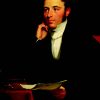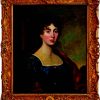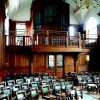Hill Street, North Adelaide is named after Sir Rowland Hill, who was knighted in later life for his contribution to postal reform and the introduction of the Penny Post in Britain. At the time the streets in Adelaide were named he was Secretary to the South Australian Commission, based in London and heavily involved in all the planning processes for the new colony.
Nothing unique can be inferred from the placement of Hill Street on the grid for the city of Adelaide, but what is special is Catherine Helen Spence’s claim that Rowland Hill was responsible for the superb parklands around the city, after his brother Matthew Davenport Hill had suggested the measure. In recounting this, Spence concluded that the Hill brothers gave hundreds of acres of ‘both beauty and health’. Whether this will ever be verified remains doubtful, especially given Arthur Leake’s claim that Osmond Gilles had a hand in the idea (see bio on Osmond Gilles).
Rowland Hill was the third son of a large Birmingham family of Unitarians, an anti-hierarchical sect of religious dissenters who denied the trinity, believed only in one God and who, in those days, wore distinctive clothing and large-brimmed black hats. They visibly stood apart in the cities, towns and countryside of late-eighteenth century England.
Hill had five brothers and two sisters. His father, Thomas Wright Hill, and his mother Sarah (nee Lea) were married soon after the Birmingham riots of 1791 when the home of their pastoral leader and noted Unitarian republican, the famous Joseph Priestley, was set alight and destroyed. (Priestley was a scientist, theologian, philosopher, educational reformer, emancipist and humanistic rationalist who attempted to fuse the principles of enlightenment, theism, toleration and human equality. He is said to have also discovered gaseous oxygen.) Thomas Wright Hill was present during this conflagration and went to the defence of his spiritual leader, successfully rescuing some of Priestley’s books and scientific apparatus.
Rowland Hill was born at Kidderminster on 3 December in 1795. He was especially close to his eldest brother Matthew and assisted him on the hustings in his run for the Reform Parliament of 1832. Matthew won the seat for Kingston on Hull, which enabled him to become an extremely important lobbyist for the South Australia Bill in 1834. The family originally sprang from the middle class of Shropshire. Rowland’s father took to Priestley’s principles with unfettered enthusiasm and after a time began teaching in his Unitarian Sunday school. This eventually prompted him to take a financial interest in a private school of his own in Birmingham, where he set about testing some of his liberal principles of cooperative and self-motivated learning. All members of his family benefited enormously from this, which goes some way to explain their unique and enlightened pathways in life.
In their formative years all the Hill children had the advantage of loving parents and a father who was deeply concerned for their education and moral upbringing. Thomas Wright Hill spent many hours encouraging them to explore and discover the world responsibly. In 1803 Rowland entered his father’s school in Birmingham, known as Hill Top. There he took to learning with great enthusiasm and, despite contracting scarlet fever, developed an amazing array of skills. Mathematics was no trouble to him. Nor was anything mechanical. He loved to experiment with manual tasks and had a passion for astronomy. At the age of 12 he began to assist his father in the teaching process, and at 13 he won a national art prize for a landscape drawing against all 16-year-olds in England.
Rowland Hill’s career as a progressive educationist and potential administrator blossomed under his father’s guidance at Hill Top. By 1819 he had become an accomplished teacher in his own right and launched a new school known as Hazelwood, in Edgbaston. The teaching methods he employed there were unique and revolutionary, so much so that the school attracted the interest of many among the progressive liberal left, especially those who came to be known as either utilitarians or Philosophical Radicals. Each school day was mechanistically organised to flow smoothly, with lesson changeovers prompted by bells and bugles. To maximise learning and to extract the most from the school day, the better pupils were taught geography entirely in the French language. These were remarkably innovative practices and they drew attention from many European thinkers, writers and educators. Visitors came from all over.
By the mid-1820s Rowland and Matthew Hill’s notoriety had given them entree to a number of intellectual, philosophical, educational and literary elites. They were both invited to become committee members of Lord Brougham’s Society for the Diffusion of Useful Knowledge, after Charles Knight, who took charge of the Society’s publications, introduced them to his Lordship. They also had a hand in advancing the liberal education of many youths in England by supporting the introduction of Mechanics’ Institutes, as well as organised sport for boys.
Rowland’s book Public Education, penned during this period, burst onto the literary scene in 1822 and created a sensation among those interested in educational practice in Britain and elsewhere. There is little in the literature about Rowland’s wife, Caroline Pearson Hill. The couple were wed on 27 September 1827 and had one son and three daughters.
By 1830 Hill had become known to some well-connected and influential people in London. He was particularly at home among intellectuals in London. Both he and his father were among the first to advocate a quota system of representation for local government, which became the forerunner of ‘proportional representation’.
By 1841 Rowland was a Fellow of the Royal Statistical Society, where he gave a paper entitled ‘On the effect of the new postal arrangements upon the number of letters’. As he became more famous, other intellectual accolades followed. In 1857 he was made a Fellow of The Royal Society and the year after admitted to the Political Economy Club.
Just how Rowland Hill became associated with the colonisation scheme is not entirely clear. However, there are several possibilities. It is most likely that he met Edward Gibbon Wakefield sometime after he was released from Newgate Prison in 1830. Wakefield decided to send his son, Jerningham, to Rowland Hill’s school at Bruce Castle, in Tottenham. It was a school which had strong moral and philosophical support from the utilitarian movement. In the 1820s Jeremy Bentham had become so enthused by the educational practices of the Hill family at Hazelwood, in Birmingham that he persuaded Rowland and his brother to open a new venture at Bruce Castle (1827). It was in effect the beginnings of an educational franchise. At this school the Hill brothers attracted a London clientele from the well-to-do families of diplomats and others, including the sons of Charles and Emma Darwin, who admired the radical and enlightened principles on which it was run.
Bruce Castle was run on the same template as Hazelwood. The teaching staff were inspirational rather than authoritarian, corporal punishment was abolished and the governance of the place pupil-centred. The curriculum was designed to emphasise science, mathematics, foreign languages and sports. William Wolryche Whitmore’s brother-in-law, Charles Babbage, the first man ever to make a simple computer, sent his sons there, so Jerningham Wakefield was in challenging company.
Rowland Hill was writing about colonisation at the same time as Wakefield, although with a slightly different twist. In 1832 he wrote a paper based on the Dutch model of land reclamation. In it he postulated that Britain had thousands of acres of swamp waste land which could be reclaimed and sold on to agricultural developers, who could then employ the destitute as labourers. This in turn, he argued, would relieve the financial burden on the parishes throughout the country.
Hill had reluctantly relinquished the headmastership of Bruce Castle because of pressure from parents to abandon science from the curriculum. It was thought by some of the more outspoken of them to be a diversionary waste of time and they made their displeasure known to Hill. His health was suffering from both the stress this caused him and the accompanying accusations that he had abandoned Christian principles in favour of Jacobin or communist tendencies.
Hence his visit to France to recuperate; a not infrequent destination by so many other subjects in this book at about that time. At an unexpected meeting there with Wakefield, the pair discussed colonial theory and the plan to launch a project inviting potential colonists to emigrate to South Australia. Hill became excited about the idea and Wakefield suggested there might be an employment opportunity for someone of his experience and enthusiasm, perhaps in one of the administrative roles. Hill made a hasty return to London and by Christmas he was on the inaugural committee of the projected South Australian Association.
This was just what Hill needed to regain his composure; however, it is noteworthy that he was only going to join the project if and when he had examined it closely. That is to say he had certain well-developed ideas of his own on how such a scheme might work and that he was not going to accept it out of any sense of desperation. After overcoming the administrative obstacles of Bruce Castle, Hill entered into his role as potential secretary-elect with great enthusiasm. He was one of the more energetic members of the South Australian Association and immediately began sorting out all the issues that needed to be considered. The task of drawing up policy and procedure fell largely to him.
By May 1835 the Commission was in a position to appoint the principal officers and sat to deliberate over each one. The role of Secretary was among the first to be considered and Hill was appointed, but not until three quarters of an hour’s opposition raised by the Tories. One can only speculate that Hill did not present well for some reason, although his earlier achievements at both his schools and on paper were outstanding. In summary, his thoroughness and meticulous attention to detail has to be one of the reasons why the colony in South Australia did at least have a propitious start. Hill was not to know that much of his work would be undermined by the inherent conflict between the Colonial Office and the South Australian commissioners, although he did suggest to Brown that some of the officers going out to the colony form a statistical society to keep records as a pre-emptive measure against any excesses that Governor John Hindmarsh might indulge.
Everything that Hill touched usually ran like clockwork. He had the uncanny ability to cover all contingencies. There are several references in the literature to his tenuous health in childhood and during his mid-30s. In addition to suffering from scarlet fever as a boy, there are inferences in some of Harriet Martineau’s commentary that he spoke with a slow, halting voice, which many people found distressing. He may even have been a stutterer, especially as it is reported that his father pioneered learning techniques to overcome stuttering.
Martineau, always a strong supporter, explained that as Rowland gained fame and confidence his emotional shackles dropped away and the true and deliberate but very accomplished thinker and writer emerged. So much so that in 1860 he was made Knight Commander of the Bath by Queen Victoria and was conferred an Honorary Doctor of Letters at Oxford University for his services to both postal reform and educational innovation.
Never wanting for something to do, Rowland Hill’s fertile mind ensured he always had several projects on the go. Even while he was busily occupied with the South Australian Commission in 1835, he and his brother Edwin patented their Rotary Printing Press, an outcome clearly driven by their roles as educational administrators. Shortly afterwards, some ideas Rowland had been toying with over the exorbitant cost of postage in Britain led to a thesis in 1837–38 which he called Post Office reform: Its importance and practicability. Under the aegis of a Whig government, and with the support of a few enterprising radical friends, especially Martineau, his ideas eventually translated into legislation and in August 1839 his principle of the Penny Post was born. However, resistance to the idea came from all quarters, including most Tory lobbyists. They were so used to paying for mail on receipt that the idea of attaching an adhesive stamp to outgoing mail seemed preposterous.
As a result of this development, Hill was given a two-year appointment in Treasury (later extended by another year) to help bring his reform into effect. However, with Sir Robert Peel’s reinstatement as Prime Minister in August 1841 a politically motivated and abstruse postal bureaucracy undermined his every move and he was let go. For the next three years Hill survived financially as a director of the London and Brighton Railway Company, which explains why his name also appeared as one of the directors of the City and Adelaide Railway company in 1849. By 1846 he had been drawn back into the government postal bureaucracy, and as his procedures gained in popularity so too did he. He was appointed Secretary to the Post Office in 1854. This was the zenith of his career.
By 1864 Rowland Hill’s health was in decline and he was forced to retire. He spent two years on the Royal Commission on railways between 1865 and 1867. His last years were spent writing a history of the Penny Post and his memoirs. He died at his home, Bertram House, in Hampstead, North London on 27 August 1879, the year in which he was given the keys to the city and perhaps the gates of heaven.







Comments